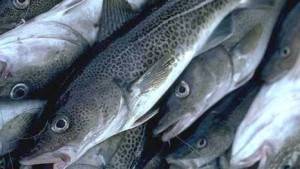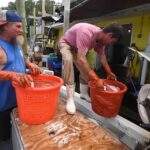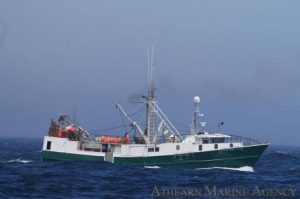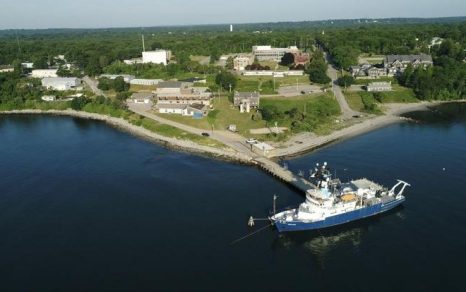Dick Grachek Responds to “Cod stocks on south coast of Newfoundland ‘OK but not great’, says researcher”
 A Response to “Cod stocks on south coast of Newfoundland ‘OK but not great’, says researcher”
A Response to “Cod stocks on south coast of Newfoundland ‘OK but not great’, says researcher”
(http://www.cbc.ca/news/canada/newfoundland-labrador/cod-stocks-3ps-cautious-zone-dfo-1.3445370)
From the above linked article posted on Fishery Nation.com: “The spawning stock is now between the ages for four and seven years, which [lead researcher Rick] Rideout called a ‘pretty restricted’ age.”
“Basically, fish are not surviving to those older ages, they’re coming into the stock … but they’re not surviving to older age, and again, that’s a big concern.”
Then abandon MSY management!
A majority of younger fish comprising the spawning stock is a function of Maximum Sustainable Yield management (MSY). This MSY management balances the numbers of larger spawning fish taken out of a stock against the numbers of individuals of smaller younger fish entering the stock or “recruitment”—guess what, this yields a highly unstable stock of smaller younger fish.
Older and wiser large fish produce larger and more durable eggs, and the somewhat cannibalistic larger fish are also a built-in restraint on the volatile younger year classes dominating a stock. So encouraging, through regulations, the taking of large fish while restricting the taking of the smaller “schoolies” from a stock is not a good idea for stock stability. But to count the (highly speculative that they’ll ever reach maturity at those specified numbers) young “recruits” and then to restrict allowable catches based on those numbers, makes no management sense at all. A healthy stock is a balanced stock of multi-year class fish.
If a younger spawning stock of fish “…not surviving to older ages” is a “big concern”, as declared by this researcher in the article below, then how about getting rid of Maximum Sustainable Yield management? MSY is the system that creates this adolescent brood stock condition for the benefit of being a handy bookkeeping tool for the convoluted computer models of the “population dynamists”. MSY focuses almost exclusively on controlling commercial fishing mortality to solve perceived stock population problems—another “handy tool”, this one for the “enforcement” of the handy rebuilding targets—while ignoring a myriad of other factors that govern stock populations.
Optimum Yield (OY) was intended to incorporate socio-economic, cultural, and ecosystem factors into the management of a fishery. This was the intent of Congress and the authors of the Magnuson Stevens Act: to manage fisheries for the purpose of yielding benefit to society (not just results measured by and confined to researchers and managers) without jeopardizing future stock health.
From the Magnuson Stevens Act, 16 U.S.C. 1801,
MSA § 2
3
(4)”to provide for the preparation and implementation, in accordance with national standards, of fishery management plans which will achieve and maintain, on a continuing basis, the optimum yield from each fishery;”
And From Nils Stolpe, fisheries consultant:
(http://www.fishnet-usa.com/maximum_sustainable_yield.htm)
From the Act (16 U.S.C. 1802, MSA § 3):
104-297
(33) The term “optimum”, with respect to the yield from a fishery, means the amount of fish which—
(A) will provide the greatest overall benefit to the Nation, particularly with respect to food production and recreational opportunities, and taking into account the protection of marine ecosystems;
(B) is prescribed as such on the basis of the maximum sustainable yield from the fishery, as reduced by any relevant economic, social, or ecological factor; and
(C) in the case of an overfished fishery, provides for rebuilding to a level consistent with producing the maximum sustainable yield in such fishery.
(34) The terms “overfishing” and “overfished” mean a rate or level of fishing mortality that jeopardizes the capacity of a fishery to produce the maximum sustainable yield on a continuing basis.
“The definition of OY supposedly allows for departures from the MSY. However, as even the casual consideration of the above section of Magnuson indicates, that is not the case, or more accurately, that is only the case when a stock isn’t at the MSY level. In that case the stock is considered to be overfished, and if it is considered to be overfished, it must be “rebuilt” to the MSY level by having the harvest level reduced.”
(http://www.fishnet-usa.com/maximum_sustainable_yield.htm)
Unfortunately, MSY has become the management approach of choice, overlooking its relationship to Optimum Yield (OY), or said in another way, OY is managing the stocks to maximum health in order for them to be utilized at an “optimum” level. Management has instead become the task of counting young fish and restricting the overall harvesting of that stock in proportion to the recruitment numbers, as if, the recruited fish will not be subject to their environment and will all make it to maturity.
MSY as an underpinning or goal or methodology of management simply does not work. This has been known and has been a point of discussion/contention for decades. Even Michel Weber who served for 4 years as a special assistant to the chief of the National Marine Service was critical of MSY management and in 2002 he wrote: “Like other scientific formulations that were incorporated into fisheries policy, the limitations of MSY… were largely ignored by decision makers and often by scientists. Among other shortcomings, these models assumed that the environment itself did not fluctuate and that the interactions among fish populations had minimal effect. Neither assumption was borne out in reality.”
Weber then quotes Carleton Ray, a scientist from University of Virginia. This comment from Ray, I think, really nails the myopic and defensive approach endemic of fisheries management: “Science can be just as obstinate and reactionary as any other field. And the traditionalists in science were the population dynamists, who were very conservation-oriented [precautionary principle champs?], but felt that the key was better use of MSY. In fact, when MSY first came around everyone thought it was a breakthrough in conservation, and it turned out to be one of the problems. Now, it’s been shown, more or less, that we were right: In management, you can’t separate our animals from their environment”. (Remarks in brackets are mine)
Quotes from Weber and Ray found in Apollonio and Dykstra’s “An Enormous, Immensely Complicated Intervention”: Groundfish, The New England Fisheries Management Council, And The World Fisheries Crisis. (This is a good little informative history tracing fisheries management from the first New England Fishery Council up to 2008.)













































